This report covers:
- Rifles only
- The old days
- First practical riflescope
- Modern scope mounts
- Updated version of Malcolm mounts
- What you are seeing
- Up to speed
- Summary
I wanted to do an accuracy test of the Gamo Arrow at 25 yards today, and for that test the rifle needed to be scoped. As I was looking for the right scope/rings combo for the rifle it dawned on me — scoping anything isn’t as straightforward as it sounds, looks or seems. There is a lot to be considered, so today I’m starting a series on scope rings. My hope is that this will help clarify some of the issues we encounter when trying to scope anything.
Rifles only
I will concentrate on rifles only in this series. Scoping handguns has its own hornet’s nest of issues and problems that differ from the issues we encounter when scoping a rifle, so let’s keep this confined to a topic we can address.
The old days
Riflescopes go back at least as far as the American Revolutionary War. Yes, back to January of 1776! The first guy who tried shooting a scoped rifle put his eye to the eyepiece of the scope he had attached to the rifle and became the first victim of “scope bite” or the artificial eyebrow. The man was Charles Willson Peale, a painter and the father of five well-known painters, the most famous of which were Rembrandt Peale and Raphaelle Peale.
As a result of his injury, Peale spent the next week or so developing a spring-loaded recoil dampener to protect his eye. It was the first acknowledgement of a scope’s eye relief.
As a side note, BB Pelletier became an incidental victim of scope bite when an 8-year-old boy got hit by the scope on BB’s Beeman R1 and dashed the rifle to the concrete in anger. His father, who was standing beside him, wasn’t quick enough to react and save the rifle.
First practical riflescope
In 1835 a civil engineer named John Chapman developed the first practical riflescope. He didn’t want to manufacture scopes so he entered into collaboration with Morgan James of Utica, New York, and in 1840 their first commercial riflescope hit the market.
Early glass was cloudy and highly variable in quality until 1846, when the German Zeiss company perfected glass manufacture of consistent high quality and clarity. The early glass also cost as much as the rifle it was mounted on — a tradition we maintain to this day (read the series on the Crosman Fire)!
In 1855 a man named William Malcolm began manufacturing scopes of 2 and 20 power in Syracuse, New York. Imagine a 3/4-inch scope tube 20 inches long!
Malcolm also developed mounts or what we call scope rings today. Malcolm’s scopes appeared on some of the Sharpshooters’ rifles used in the American Civil War. Malcolm’s scopes and mounts were so successful that replicas of them are still being made and sold today. And modernized offshoots of the scope rings he designed are still in high demand by target shooters.
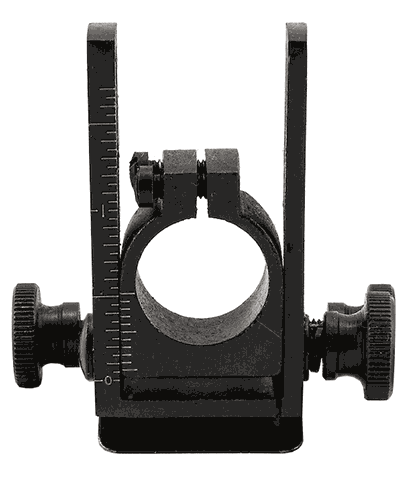
The Malcolm rear scope mount also contained the elevation adjustment.
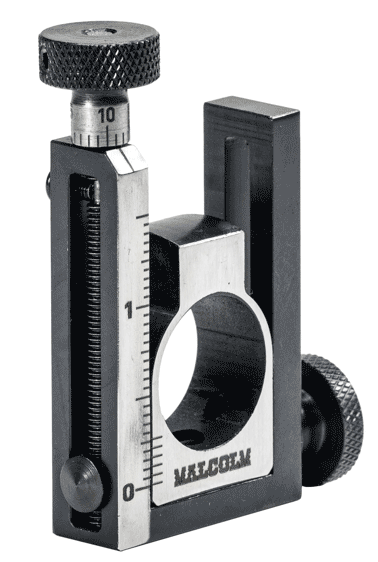
The modern version of Malcolm’s rear mount hasn’t changed that much.
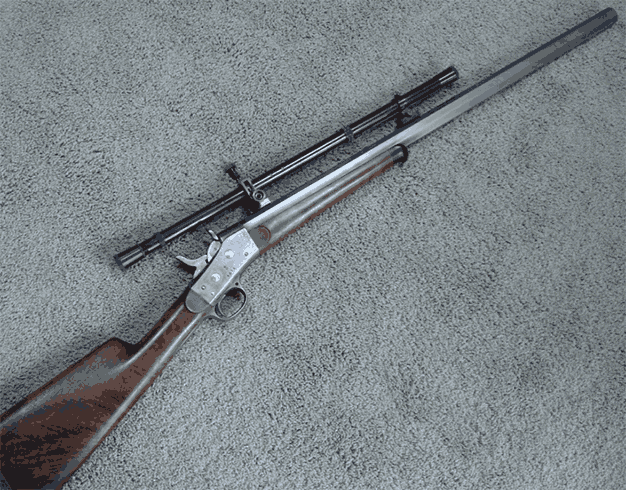
This is a Unertl target scope that the Malcolm morphed into. These were popular in the 1930-1970 timeframe.
Modern scope mounts
Malcolm’s rear scope mount looks pretty archaic compared to what we use today. That’s because it does the adjusting for elevation outside the scope. And that, in turn, is because of how fragile those early riflescopes were. Their crosshairs were often single strands of spider webs. And that technology lasted up to and through the Second World War! Even bomb sights used strands from spider webs as reticles. Until scope makers found ways to make the scopes more rugged inside, the mounts had to do the adjusting.
This is not a report on scopes. We want to talk about scope rings, and sometimes I use the term scope mounts to mean rings. But to understand where scope rings have come from we have to first understand the scopes they held.
Updated version of Malcolm mounts
You see the updated Malcolm scope in the picture above. Now look at another one and the updated version of the Malcolm mounts.
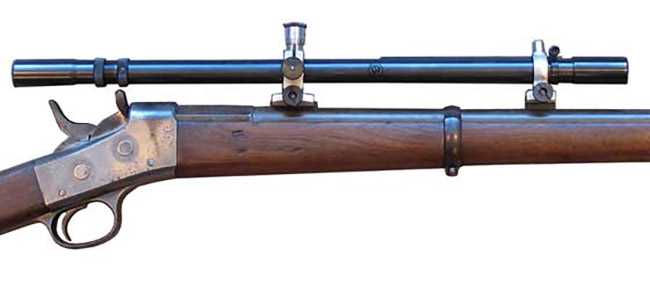
This is a .43 Spanish Remington Rolling Block with a Unertl target scope.
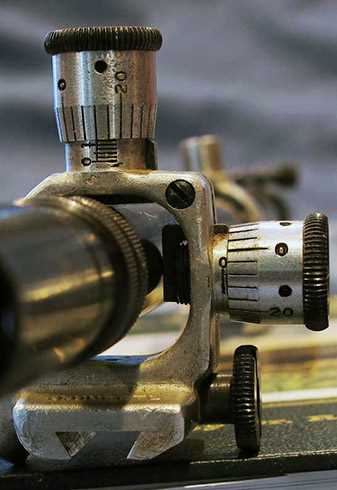
There are the external spring-loaded scope adjustments for windage and elevation.
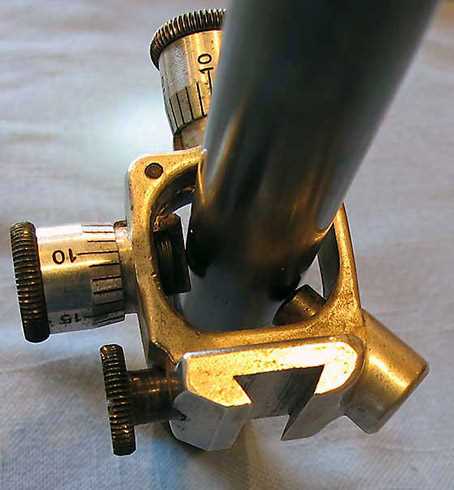
And there is the external return spring that pushes the scope against the springs in both adjustment knobs.
What you are seeing
What you are seeing in this 1940’s vintage Unertl scope and mounts is a scope that performs the job of the erector tube inside a modern scope tube. Here it’s all on the outside to see. And recoil has little affect on this scope because when the rifle moves in recoil the scope stays in one place. The rifle slides underneath it! But on some of those scopes, like the one shown here, you have to remember to push the scope forward and into battery after the shot.
Up to speed
Now you are up to speed. That Unertl scope has a spider web reticle, by the way. But spider silk won’t do when hundreds of thousands of scopes have to be made each year, and the retail price for them has to be extremely low. Spider silk is too labor intensive. In our next look we will examine what happened when modern production took over.
Summary
The scope rings we use today evolved alongside the riflescopes they hold. In this report we have moved from 1776 up to around 1940 in scope technology, and scope mounts that held them had to keep pace with developments. Here is a look at where this report is going.
What do you have to know to order scope rings for your airgun? Size of the scope? Recoil of the airgun? Intended use for the scoped gun? Scope base on the airgun? Is there more?


Here’s my contribution:
One also has to know the required scope height which may depend on where the shooter’s eye is, and also, whether one wants to be able to use the open sights below the scope.
Hihihi,
Also, on some rifles, the scope has to be mounted high to clear the magazine.
Hank
Vana2 oh yeah, of course and very important too!
Not directly scope related:
I remember when I first saw the Diana Mauser K98 PCP and thought I would like one of those…
…but got their springer version instead because it didn’t have the protruding magazine. 🙂
Not exactly what you need to know to order but keeping the rings in the exact orientation they came in. Don’t reverse the caps or interchange them with other bases to keep the scope bore hole true and not pinch the scope with misaligned halves. Especially with low cost rings .Check for alignment inside with your fingernail
Bob M,
Those are things one should definitely keep in mind. You get what you pay for. I had fully adjustable rings on my HM1000X. The air rifle is gone, but I still have the rings.
RR,
What did you get in place of the HMX 1000?
Brent
.457 AirForce Texan LSS with CF tank. I was wanting a relatively accurate long-range thumper. The HM1000X .357 is extremely accurate but does not have enough umph to suit me.
Wow! You got the 45/70 of air guns! Now you can go buffalo hunting 🙂
RidgeRunner,
NICE!
May you always hit what you take aim on with her!
Hunter-Supply for a good selection at reasonable Bullet prices. Mr. Hollowpoint of course for some SPECIAL ones.
shootski
Brent,
LOL! I do not see me buffalo hunting, even if there is a small herd not far from me. Now, a deer might be in trouble.
BB,
I like that scope on top of that first rolling block. I even like the rolling block underneath it. That is a nice looking piece of glass and some mighty purdy wood.
I have a very strong affinity for these types of scopes. I used to rebuild Mossberg scopes. Like the fool I am, I sold all of them. Now the price on those things have skyrocketed. Ah well, live and learn.
P.S. I used to have a Pedersoli rolling block in .45-70. That was another one of those things I let go and should have hung on to.
RidgeRunner,
Hate to be the bearer of bad tidings…but….
Unfortunately Wm. Malcolm, Unertl, and Hi-Lux are all made in one of your least favored countries. They self proclaim to be one of the “better” optics manufacturers…but the Swabians have a saying for that: Eigenlob stinkt.
Funny but it dovetails with another German cultural Fauxpas:
Selbstbeweihräucherung.
Notice the root word Weihrauch in that German compound word!
So interesting that a company would call itself incense burners…smoke screen?
Let the calls for burning at the stake begin!
shootski
Shootski:
Love those Schwabians,,,
Motorman (Speidel)
Eastern MO
Shootski,
Sorry, but the references (German?) go right over my head.
As for the least favorite country, if you are referring to China, they are almost the only country in the world making optics. I would sorely like to buy USA or European made optics, but I am not a gazillionaire. I wish they would ban Xi and his cohorts. It would be rough for quite a bit, but it would settle out. We would be better off.
Hehe shootski, you’re definitively a very knowledgable guy and could easily pull the wool over my gullible eyes.
But not this time. 🙂
Weihrauch HW [model no.] guns are definitively not (!) named after incense but the manufacturer’s surname, Hermann Weihrauch. A bit like Robert Beeman’s choice of name for the airguns which he wished to promote and sell… 🙂
Holy Smokes! Always good to learn or be reminded of interesting things. As for other issues, and not wanting to start inappropriate off-topic threads, but since we are living in interesting times, FM is reminded of a work he read about 20 years ago by Hal Lindsey titled “The Late Great Planet Earth.” At the time, thought his theories were more along the lines of historical fiction than not, but now believe they are more than plausible. And FM sincerely hopes both he and Mr. Lindsey are wrong. Meantime, keep on truckin’ and airgunning, passing on the love of your hobby to the younger generation.
FawltyManual,
“Holy Smoke(s)”. From a Censer?
Good one!
I think we will be okay if we all make it through the Northern Hemisphere’s Winter!
It is going to be a rough 6-8 months.
Hopefully there will not be another Black Swan Event during that timeframe.
shootski
hihihi,
Wool!
I knew I shouldn’t use that polyester blanket!
shootski
Ah shootski, you Sir, have a great sense of humour! 🙂
shootski,
I have been hearing/seeing that these are pretty accurate in this air rifle.
https://nielsenspecialtyammo.com/collections/45-cal/products/350-grain-boat-tail-hollow-point
RidgeRunner,
My DAQ .308 1:10 has consumed a few of the NSA bullets. I think I have a few of the .45 but have been too busy with the ASP20’s of late.
The DAQs are not that picky other than the correct length for spin and a really tight fit to the bore.
I’m pretty much stuck in place with a complete renovation started on the main digs. I don’t even know if i will see the SkiShed much this Winter. The area is getting 2′-3′ this weekend at the SkiSheds elevation! Dang!
Hope the hunters and Backcountry hikers are well equiped or gone home frome the Great Basin and surrounding mountains!
shootski
October 28th and 29th, next Friday and Saturday, is the 8th Annual North Carolina Aiirgun Show.
https://www.tmacsairgunservice.com/
https://gunshowtrader.com/gun-shows/north-carolina-airgun-show/
It is an awesome show! I have been to it three times now. I will be there on Saturday.
Be there or be square!
RIdgeRunner,
I will be there again this year and will have several old airugns, all available to shoot if you like.
Paul
Paul in LC,
I will be wearing a light gray Stetson with a black braided head band. Make yourself known to me.
RR – FM square this year. 🙁
FM,
🙁
B.B.
Great report!
Seems that I would be harder to runout of elevation with the externally mounted adjustment these early scope rings offered? The modern, tube within the scope offers little adjustment, where as these older ones scope mounts offer much more.
-Y
Not really. Look at the length of the Unertl scope and the distance between mounts. Now, compare the length of the internal tube and differential between pivot point and adjuster points. Simple geometry.
An Unertl scope, so that is what it was!
BB,
Years ago (decades actually) I made a stock for a guys “uber” custom made varmint rifle (it used a 30-06 case necked down to .22 caliber and solid brass bullets) that he claimed extremely high velocities for.
The rifle (more a small artillery piece) had a Unertl scope with external adjustments. First and only time I’ve seen that setup.
Hank
Ahhh……. The heyday of wildcat cartridge ‘development’. Before easy and cheap access to accurate chronographs, it seemed like everybody and their brother was necking up or necking down existing cartridges to create new wonders that that were somehow better. Results were all over map. Speed was frequently the ultimate goal for bragging rights if nothing else. The various 22-06 rounds had somewhat better results on target than say the 220 Swift (itself a necked down 6 mm Lee Navy), at the cost of considerably larger powder charges and much reduced barrel life. And the 220 Swift is considered a barrel burner. The less drastic 25-06 ended up going mainstream and is still with us.
Vana2,
Hey Hank the US Army did some testing with the Frankford Arsenal IIRC in the early ’50s with .30 06 cases necked down to .22 caliber for duplex/triplex loads (2 or 3 stacked bullets)
The velocity was often amazing for single loads back then but ho hum by todays standards. The barrel wear replacement alone would have bankrupted most Armies/Nations.
Not very accurate due to bullet making and powder technology extant as well.
Did you ever hear how well his varminting went?
shootski
Shootski,
Went out on one hunt and saw him take out a couple of crows and groundhogs at long range (150 yards??).
Hank
Hank,
The .25-06 is much better than that thing. I have shot groundhogs in the head at over 500 yards with a Rem 700 Varmint Special with a Weaver 12X scope. Like Paco was saying, a lot of those “wildcat” rounds were really quite disappointing. Some were real sizzlers, but that ain’t everything. That is why many have gone away.
.25-06 is a very versatile round. I use mine for deer hunting. It’s a Remington 700 BDL with the skip line checkering that dear old Dad got me for my 12th birthday. Still puts meat on the table. But I recently bought a beautiful vintage Mauser 98 sporter conversion in .257 Roberts. I bought it because the stock was so cool looking, and I figured I couldn’t go wrong at that price. I will hunt with it this year, and then we’ll see if it will stay or be sold to fund my airgun collection.
RR,
Being a “sneak up close and stick the barrel it his ear” kinda guy describes my groundhog hunting style. 🙂
The areas I hunted were mostly hardwoods and heavy alder bush, never got into the long range varmint stuff.
Hank
Vana2,
That is bb gun range these days!
shootski
Hank,
Until I was sixteen, I hunted groundhog with a .22LR. It many times was up close and personal. After that I used a .223. The .25-06 was my Dad’s. He would let me use it every once in a while.
B.B.,
The use of spider silk for the reticle is a fascinating bit of history. I learn such interesting things on this blog. I enjoy the coverage of specific airguns (especially the classics and springers), but really appreciate it when you share the fundamentals, or other broadly applicable areas of general shooting and airgun knowledge. Good work, B.B.
-Airman
B.B.,
“What do you have to know to order scope rings for your airgun? Size of the scope? Recoil of the airgun? Intended use for the scoped gun? Scope base on the airgun? Is there more?”
I’ll bite:
Steel or Aluminum (alloy)
Single or Pair
Leupold, Weaver, or true PICATINNY 1913
OR… (STANAG: God FORBID!)
Tip Off Rings, Quick Detachable Rings, adjustable rings (Elevation/Windage,) Cantilever (Extension Rings,) and 45°/30° angle rings…
MOA/MIL adjustable bases or Fixed MOA/MIL cant Rails
Unfortunately there is probably no easily found PERFECT Optic to Rifle system you will likely have some elements that are compromised.
Your wallet will be among the first casualties.
shootski
PS: had to include…
Center or lower third cowitnessed
BB did mention Recoil as an Item to consider and that can really be dealt with using a Recoil Absorbing Diana Bullseye Scope Mount. Kinda fell from the limelight lately but worth consideration when shooting a Magnum Springer Air Rifle.
Bob M, thanks for making me aware of the Diana Bullseye ZR Mount. For at least 7 years I never knew nothing not no-how ’bout it, hmm… 🙂
According to many reviewers, Diana have yet to address the BIG problem: too often the scope is held so sloppily that accuracy cannot be achieved, ie they’re effectively useless.
What a shame and waste of a good idea! 🙁
So, does that leave the Sportsmatch Dampa Mount as the only useful, jolt protecting scope mount?
hihihi
I have read some reviews that say just the opposite, and that there is an upgraded version out now? Have no info on it.
Perhaps it is not well suited for precision target shooting, or at least not the first choice.
But think about it. Neither is a Magnum powered springer air rifle it was designed for.
It is a scope saving mount with moving parts. And the compromise may be a little accuracy. Looks like some good grease may help it work better?
Seems like the Sportsmatch Dampa has a similar problem.
One of these, open sights or some dot sight that holds up to a beating. Look into the upgraded one. Not sure what they did to it.
Sorry for the delay, lost internet for a while.
Bob M, I received a notification of your reply to my comment only today. I guess, better two days late than never, eh?! 🙂
That the Dampa Mount can affect accuracy is news to me. I wonder if Sportsmatch’s lifetime warranty covers that…
I couldn’t find out what, if anything, may have improved for the updated Diana Bulleye ZR Mount. By the way, and for your interest, the multiple criticisms I referred to, were in the reviews on Pyramydair.
As for me, I have recently received a Weihrauch HW90 springer which I want to make more powerful. I expect a harsher recoil and so I plan to mount either a Hawke or Leapers scope on a Dampa.
But first I need to get the bits’n’bobs to increase the air ram pressure. 🙂
hihihi
I found blog entries in Airgun Nation by searching ‘Sportsmatch Dampa Mount v Diana ZR Mount’ and ‘Sportsmatch Dampa DM60 or Diana Bullseye ZR 25.4mm. on line. Not impressed with the Dampa there.
Also found info on the Diana ZR here, ‘ctcustomairguns.com/hectors-airgun-blog/march-14th-2016’ He explains the modification they did to the Diana ZR mount also. Good luck.
Thanks Bob M, for sharing your research sources.
I’m still unsure what exactly the issue is with the Dampa Mount.
Hector Medina’s explanation on the Bullseye ZR Mount was highly interesting (!) and helped me make a better informed decision: Dampa. 🙂
Roamin Greco,
We ran out of room upstairs.
The .257 is a good round from my understanding. You should like it. My Dad had a custom .270 Winchester made from an Argentine Mauser. That was his deer rifle. The Mauser action is awesome.
“Their crosshairs were often single strands of spider webs. And that technology lasted up to and through the Second World War! Even bomb sights used strands from spider webs as reticles.”
B.B.,
With an extra long “honey do” list this week, I am late to the party as I just got a chance to get a cup of caffeine and read through this most excellent report. As someone who worked for Norden Systems (but not back in WWII !), and worked in the building where we had a Norden bombsight from WWII on display in the lobby, I found the history of the spider web strands particularly interesting; I love these types of reports; thank you! 🙂
Take care & God bless,
dave
Off-topic and motivated by Airman of the Board and thedavemyster (and Tom Gaylord (B.B. Pelletier) of course), I remember hearing that spider silk is supposed to be stronger and more elastic than anything man made. Maybe someone can correct me in thinking that it’s used in catching fixed wing aircraft when landing on ships.
Another use of cobwebs was for poor artists who struggled to buy canvasses. They would go for a walk at first light when the morning dew would make cob webs easily visible and push a small wooden frame against them. In this fashion they would eventually gather so many webs as to effectively create a silk screen so dense that it could be painted on.
I don’t know how true any of the above hearsay information actually is but I trust the sources. 🙂